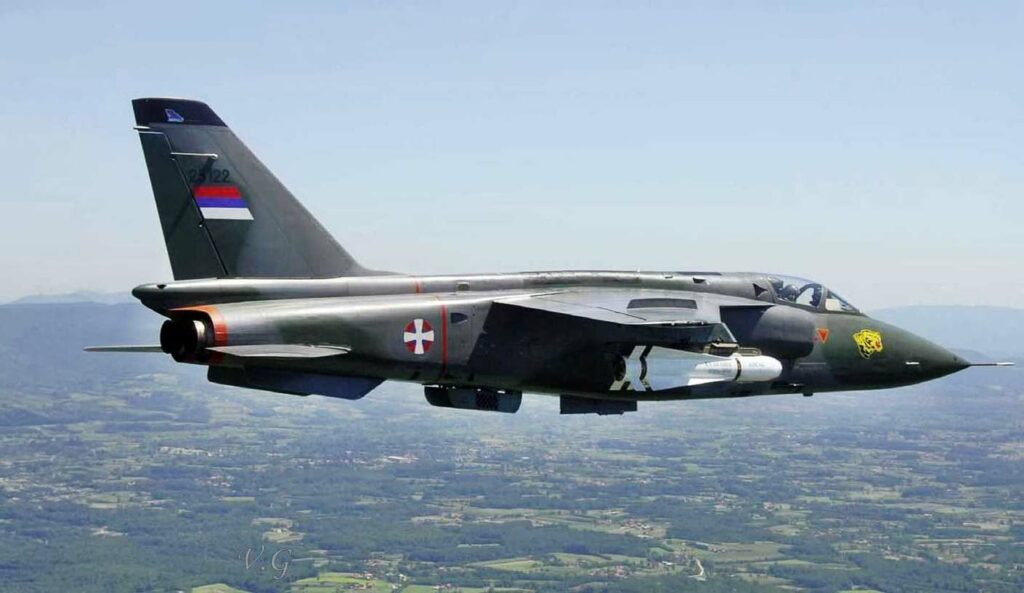Romanian-Yugoslav attack aircraft, twin-engine, subsonic, ground-attack and reconnaissance capabilities.
In brief
The Avioane IAR 93 Vultur is a joint Romanian-Yugoslav tactical, subsonic attack aircraft, designed in the early 1970s. It is powered by two Rolls-Royce Viper Mk 632-41 engines, each producing 4,000 lbs of thrust. The aircraft has a maximum speed of 527 mph (848 km/h), a range of 621 miles (1,000 km), and can operate up to a ceiling of 36,090 feet (11,000 meters). Its design features fixed wings with a high-mounted tailplane and tricycle undercarriage, optimized for short takeoffs and landings, suitable for operations from forward airfields close to battle zones.
History of the Development of the Avioane IAR 93 Vultur
Developed during the Cold War, the Avioane IAR 93 Vultur emerged from a political and military necessity shared between Romania and Yugoslavia to bolster their defensive capabilities independently of Soviet influence. Initiated in the late 1960s, the collaboration aimed to produce an aircraft capable of multiple roles, including ground attack and reconnaissance.
The program formally started in 1968 under the code name “YuRom” — a portmanteau of Yugoslavia and Romania. Both nations sought to enhance their technological landscape and military autonomy, diverging from their reliance on Soviet aircraft. The development project aimed to create an aircraft that could perform in diverse conditions prevalent in both countries, ranging from the plains of Vojvodina to the Carpathian mountains.
The first flight of the IAR 93 took place on October 31, 1974. It marked a significant milestone, not only technically but also politically, as it underlined the capability of Eastern Bloc nations to develop complex military systems independently. The aircraft was introduced into service in the late 1970s, gradually replacing older Soviet models previously dominant in Eastern European air forces.
There is no specific NATO nickname for this aircraft, which is often the case when the aircraft does not play a significant role in NATO operations or strategy.

Design of the Avioane IAR 93 Vultur
The IAR 93’s design is robust, featuring a dual-engine setup that ensures reliability and sufficient power for low-altitude attack runs and quick ascents. Each engine, a Rolls-Royce Viper Mk 632-41, offers a thrust of 4,000 pounds (17.8 kN), enabling operations from shorter runways—a crucial feature for tactical flexibility.
The aircraft has an overall length of 47 feet (14.3 meters) and a wingspan of 28 feet (8.56 meters). The airframe design incorporates a high-mounted tailplane and a tricycle undercarriage, which supports operations from less prepared runways. The fuselage is equipped with armor to protect the pilot and critical systems from ground fire, a common threat in low-altitude missions.
However, the design has its drawbacks. The reliance on older jet technology limits its speed and maneuverability compared to more modern aircraft developed in the West during the same period. Moreover, the airframe, while rugged, resulted in a heavier aircraft, reducing its payload capacity relative to its size and engine power.
Performance of the Avioane IAR 93 Vultur
The IAR 93 Vultur is powered by two Rolls-Royce Viper Mk 632-41 engines, each capable of producing 4,000 pounds of thrust, which translates to a total thrust-to-weight ratio that favors strong, albeit not spectacular, performance metrics. The aircraft reaches a top speed of 527 mph (848 km/h), with an operational ceiling of 36,090 feet (11,000 meters) and a range of 621 miles (1,000 km).
Compared to its contemporaries like the American A-10 Thunderbolt II, the IAR 93 does not excel in payload or advanced avionics but offers respectable performance in the ground attack role. It was particularly valued for its ability to operate from forward, often rudimentary airfields— a critical capability in the tactical environments envisioned by its operators.
Variants of the Avioane IAR 93 Vultur
Several variants of the IAR 93 were developed to enhance its operational capabilities and adapt to different military needs. The initial production model, IAR 93A, focused on ground attack roles with basic avionics. It was followed by the IAR 93B, which featured upgraded engines and improved navigation systems. A reconnaissance variant was also introduced, equipped with cameras and sensors for intelligence gathering, designated as IAR 93C.
Military Use and Combat of the Avioane IAR 93 Vultur
The IAR 93 was armed with a combination of two 23mm cannons and provisions for up to 2,200 pounds (1,000 kg) of mixed ordnance, including bombs, rockets, and external fuel tanks. The aircraft saw limited combat use, primarily within the borders of Yugoslavia during the Balkan conflicts in the 1990s. Its roles included close air support for ground troops and tactical reconnaissance, providing crucial data on enemy movements and positions.
The aircraft was never exported, limiting its combat history to the regions controlled by its creators. By the late 1990s, the IAR 93 was phased out, replaced by more modern aircraft like the American F-16, which offered superior speed, agility, and advanced electronic warfare capabilities.
The Avioane IAR 93 Vultur was a significant Eastern European military aircraft project, reflecting the regional desire for military self-reliance during the Cold War. While it did not match the high-tech standards of Western aircraft from the same era, its versatility and adaptability to the rugged environments of Eastern Europe made it a valuable asset to the Romanian and Yugoslav air forces during its service life.
Back to the Fighter Jet section.